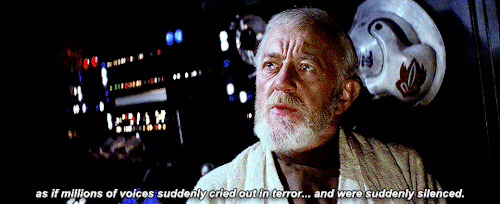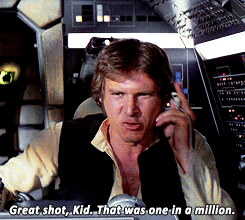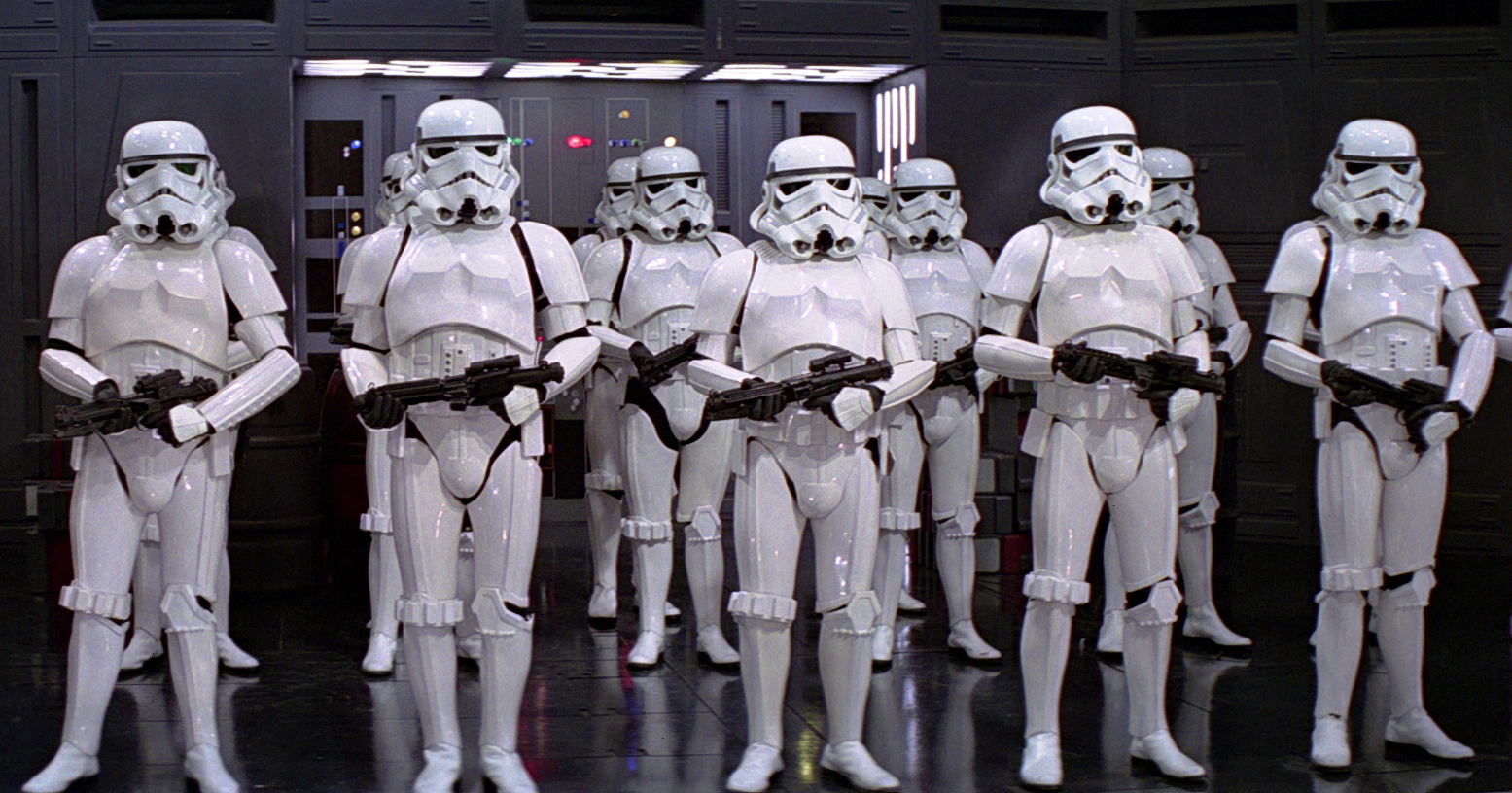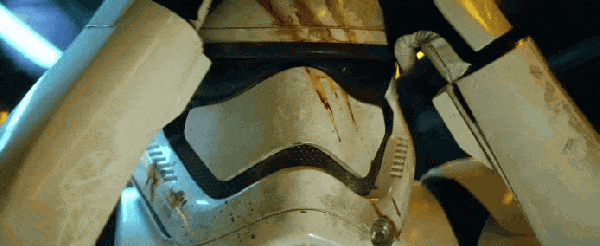That’s Not How Rebellion Works!: Reexamining the Rebel Alliance as a Wholly Good Entity
Throughout the Star Wars movies, the Rebellion is painted as the epitome of good, and the Empire as the representation of pure evil. However, upon deeper analysis, the reality of the Rebel Alliance’s ruthlessness is veiled by the careful mediation of the movies and how their actions are portrayed compared to those of the Empire. The Rebellion’s reasons for violence are unclear and said violence seems superfluous; their justification for wanting to take power away from the Empire for themselves is never explained, yet the audience quickly and wholeheartedly accepts them as the heroes of this saga. Though the Rebellion has become synonymous with the image of good in modern culture, it actually commits unspeakable violence that is equivalent to, if not more gruesome than, the violence of the Empire, which completely subverts the narrative that the Star Wars enterprise has been telling for decades and exposes how the mediation of the movies has made this false belief possible.
Albert Camus visits the argument of the necessity of violence in rebellion in his essay, “The Rebel.” He analyzes the theoretical and philosophical motivations behind a rebellion and ultimately suggests that the acts of murder and rebellion are inherently contradictory. He also implies that rebels can get carried away by the crimes they commit and that this leads them astray from their original intentions for rebelling. Camus rejects the use of violence to stage a successful uprising; the saga leads the audience to believe the opposite, that destruction is a key component to winning a rebellion. Both the Empire and Rebel Alliance resort to brutal maneuvers in their fight for power. The Empire uses torture and indoctrinates Stormtroopers to be totally obedient to the Emperor while the Rebels send several squadrons on suicide missions for information; their collective body count is in the billions. The original Star Wars trilogy ends with the Empire in ruins. The Rebel Alliance can now assume power (and it does) but has no concrete plans for how it will move forward in reforming the galaxy, which raises the question of what its goals were in the first place, and why it needed to go to such extremes to secure power for itself.
In her essay, “What is Authority?,” Hannah Arendt discusses the place violence has alongside authority and the cyclical nature of rebellion. She claims that “…violence is authority,” and authority cannot be maintained without committing violence against the oppressed group (Arendt 7). This suppression caused by authority, coupled with the power exacted over the oppressed group, leads to rebellion and the upheaval of the established authority and power structures. Now that the subjugated group has subverted the balance of society, they are now able to abuse those below them, restarting the cycle of oppression. Arendt’s theory of what causes rebellions and their repetitive nature calls into question the Rebel Alliance’s motives for gaining power. According to Arendt’s thinking, it is inevitable that they will eventually repeat the actions of the Empire and become an oppressive regime. We can then conclude that the Rebellion has no concrete justification for the millions of lives it takes in their fight for power in the galaxy if its actions in power will lead to more oppression.1
The Rebel Alliance is presented as a symbol of pure good for Star Wars viewers. However, upon closer inspection, the Rebellion is comparable to the Empire in terms of brutality and is just as guilty of taking the lives of millions of innocents caught in the middle of the war. Analyzing this greatly changes the Rebellion’s appearance from a pillar of good to a morally ambiguous and ruthless movement. Therefore, many major events throughout the Star Wars movies need to be reconsidered. While the Empire is painted as heartless and brutal when it destroys Alderaan, the Rebellion is seen as victorious when it destroys both Death Stars. Additionally, the deaths of Stormtroopers are seen as insignificant background action, since they are portrayed as faceless pawns that the audience has no sympathy for. Finally, the Rogue One squadron sent to Scarif to retrieve the Death Star plans consists wholly of Rebel members who have morally corrupt pasts, calling into question the underlying morality of the Rebellion.

“I felt a great disturbance in the Force, as if millions of voices suddenly cried out in terror and were suddenly silenced. I fear something terrible has happened.”
The original trilogy features the destruction of three equally major structures in the galaxy, both Death Stars and Alderaan. These three explosions are nearly identical, however, one is presented as a tragedy and two are presented as victories — this is done by choosing what reactions are shown after each explosion. After capturing Princess Leia in the beginning of A New Hope, Grand Moff Tarkin, a governor within the Empire, has “chosen to test [the Death Star’s] destructive power on […] Alderaan” as punishment for her withholding of the Rebel base’s location (Lucas, A New Hope). He issues the order, and Alderaan is obliterated in a matter of seconds. Immediately after the explosion, the movie cuts to Obi-Wan’s physical shock to the event, since he can sense it through the force. Based on his reaction, the audience is cued to think that what just happened was incredibly horrific and that the Empire just did something unspeakably wrong. Though Leia tells Tarkin otherwise, Alderaan is the Rebellion’s main source of weapons and ammunition and houses approximately two billion people (“Alderaan”). The destruction of Alderaan serves two purposes for the Empire: it lowers Leia’s morale since she was raised on Alderaan and it greatly weakens the militant portion of the faction rebelling against the Empire since Tarkin was aware of the strong presence of Rebel sympathizers on the planet (“Wilhuff Tarkin”). In the eyes of the Empire, these rebels are a serious threat to the status quo the Empire has struggled for years to create and maintain; the Empire strives to create a galaxy of peace and order, which the Rebellion directly challenges and disrupts. However, the Empire is still guilty of killing billions of innocents in a broad preventative measure, rather than trying to specifically target the rebelling areas within Alderaan.

“Great shot, kid! That was one in a million!”
At the climax of A New Hope, the rebels successfully blow up Death Star I. Though the scales of both attacks vary greatly, there are still many parallels. The Death Star is an immense structure, mistaken for a moon in the movie, that poses a major threat to the Rebel Alliance and the galaxy. It exhibits its power with the destruction of Alderaan and is on course to destroy the planet of Yavin as well before the Rebel Alliance intervenes. Though the Death Star holds less than one-and-a-half million personnel, all of them are killed without any forewarning, and the Rebels count this as a major win for their cause (“Death Star”). In contrast to Obi-Wan’s reaction when Alderaan was destroyed, the Death Star’s explosion was followed by a jubilant Han Solo commending Luke for successfully landing the fatal shot that sealed the Death Star’s fate. The audience should likewise feel Han’s excitement and celebrate alongside the Rebels in their victory, even though over a million people just died.
Return of the Jedi also sees to the destruction of Death Star II, this one in the midst of being constructed to be larger and more powerful than its predecessor. The episode “Workin’ on the Death Star,” from the Imaginary Worlds podcast addresses the destruction of this Death Star. Specifically, it analyzes the morality of killing the independent contractors who were working on this Death Star when the Rebellion blows it up; there is a debate about the value the Rebellion places on the lives of those who are associated with the Empire, regardless of their occupation or level of involvement with the Empire. The podcast estimates that a “crew of over 265,000” were aboard the second Death Star, most of whom were independent contractors (Molinsky). The podcast introduces many reasons why these contractors would have been working on the Death Star, aside from just loyalty to the Galactic Empire, such as income or coercion; as we see in Rogue One, Galen Erso is coerced and forced into working on Death Star I, so the Empire is not above using threats to gain employees. The Rebels’ attack was meant to destroy the weapon and trigger the downfall of the Empire, not to take lives.  Those aboard the Death Star were non-combatants who were not a threat to the Rebellion. However, the Rebellion disregards any chance of these hundreds of thousands of personnel being innocent and kills them all in one swift blow. Following the explosion is an overjoyed Lando, who executed the Death Star’s downfall,
Those aboard the Death Star were non-combatants who were not a threat to the Rebellion. However, the Rebellion disregards any chance of these hundreds of thousands of personnel being innocent and kills them all in one swift blow. Following the explosion is an overjoyed Lando, who executed the Death Star’s downfall,  and large celebrations across several planets for the Rebels’ victory.2 These reactions divert the audience’s attention away from the people who were just killed on the Death Star and frame the incident as a major win. Both the Rebellion and Empire are guilty of committing horrific mass murders for their cause in the original trilogy, yet the Rebellion is wrongfully commended for its actions against the Empire, while the Empire alone is demonized.
and large celebrations across several planets for the Rebels’ victory.2 These reactions divert the audience’s attention away from the people who were just killed on the Death Star and frame the incident as a major win. Both the Rebellion and Empire are guilty of committing horrific mass murders for their cause in the original trilogy, yet the Rebellion is wrongfully commended for its actions against the Empire, while the Empire alone is demonized.
The personnel aboard the Death Stars are not the only deaths that the audience is numbed to. Aside from the extensive deaths aboard the Death Stars, the individuals we see killed by the Rebellion are most often Stormtroopers, but to call them individuals is a stretch. They wear identical black and white helmets, and their voices are muffled and warped through their masks.  They are faceless, nameless pawns in this civil war — they are dehumanized and portrayed as their own species. Nothing differentiates one Stormtrooper from another, and the first and only unmasked Stormtrooper the audience ever sees is Finn in The Force Awakens, who ends up joining the Resistance and becoming one of the “good guys.”3 By giving Stormtroopers complete uniformity and anonymity, the audience has no emotional attachment
They are faceless, nameless pawns in this civil war — they are dehumanized and portrayed as their own species. Nothing differentiates one Stormtrooper from another, and the first and only unmasked Stormtrooper the audience ever sees is Finn in The Force Awakens, who ends up joining the Resistance and becoming one of the “good guys.”3 By giving Stormtroopers complete uniformity and anonymity, the audience has no emotional attachment s to them. Thus, showing the audience the onscreen deaths of hundred of Stormtroopers throughout the course of the Star Wars saga draws no sympathy. The deaths of the Rogue One squadron are tragic and heartbreaking because the audience has grown attached to these characters and has seen them grow and interact with others; however, the Stormtroopers are not given that luxury and their deaths merely add to the enticing violence of battle for the audience. By forming the Stormtroopers into a single mass, the audience sees them all as equally evil and equally guilty in participating in the Empire’s wrongdoings. Though the movies disproportionately show more Stormtrooper deaths than Rebellion members, through their thoughtful portrayal, the audience never sees the Rebellion as guilty for these murders, but rather doing what is necessary.
s to them. Thus, showing the audience the onscreen deaths of hundred of Stormtroopers throughout the course of the Star Wars saga draws no sympathy. The deaths of the Rogue One squadron are tragic and heartbreaking because the audience has grown attached to these characters and has seen them grow and interact with others; however, the Stormtroopers are not given that luxury and their deaths merely add to the enticing violence of battle for the audience. By forming the Stormtroopers into a single mass, the audience sees them all as equally evil and equally guilty in participating in the Empire’s wrongdoings. Though the movies disproportionately show more Stormtrooper deaths than Rebellion members, through their thoughtful portrayal, the audience never sees the Rebellion as guilty for these murders, but rather doing what is necessary.
The Rebellion members presented in Rogue One raise another question about the Rebellion’s ambiguous intentions. Taking place right before the events of A New Hope, Rogue One tells the story of how the Rebel Alliance was able to acquire the blueprints for the first Death Star. This is made possible by a squadron calling themselves “Rogue One,” who volunteer to infiltrate the Imperial data bank on the planet Scarif. They are “spies… saboteurs… assassins” — they have “done terrible things on behalf of the Rebellion;” the movie even begins with Cassian, a captain and intelligence agent for the Rebellion, killing an innocent man in cold blood (Edwards). Though many left the theater in tears after Rogue One — sympathizing for these flawed individuals — the movie shows the audience that the Rebel Alliance’s members are not as pure as they seem, much like the Alliance itself. Rogue One is the first movie to address the imperfect pasts of Rebellion members, and now calls into question the pasts of every other Rebellion member. Since the events on Scarif constitute the first major victory for the Rebellion, it shows that the Rebellion has its foundations fixed using whatever means necessary to the cause, even if that means killing innocent people, a trend that the Rebellion does not break.
While the Rebellion is fighting against an authoritarian government to restore a republican government in which the citizens of the galaxy would live with more rights and representation, the mediation of the movies creates a scenario that places the Rebellion and Empire as complete moral opposites, which they are not. The Rebel Alliance is just as guilty as the Empire for crimes it commits onscreen that are mistaken as heroic victories. The Rebellion murders thousands upon thousands throughout the Star Wars saga without remorse, and veils the measures it takes to further its goals, even though the crimes of the Rebellion and Empire are quite similar. Through analysis of the Rebellion’s destruction of both Death Stars, killings of Stormtroopers, and the individual actions of its members for the cause, the Rebellion is actually corrupt, despite how it is portrayed. The mediation of this film series compels the audience to undoubtingly believe in the goodness of the Rebellion and provides a skewed image of how a rebellion actually occurs. It implies that rebellions have clean-cut “good” and “bad” sides, and that rebellion is adventurous and even appealing. A closer examination of the films changes the portrayal of the Rebellion from a symbol of good into a realistic, brutal group of revolutionaries.
Works Cited
“Alderaan.” Wookieepedia, starwars.wikia.com/wiki/Alderaan.
Arendt, Hannah. Between Past and Future. Viking Press, 1961.
Camus, Albert. The Rebel. Vintage International, 1991.
“Death Star.” Wookieepedia, starwars.wikia.com/wiki/Death_Star.
Edwards, Gareth, director. Rogue One: A Star Wars Story. Walt Disney Studios Motion Pictures,
Lucas, George, director. Star Wars: A New Hope. 20th Century Fox, 1977.
Molinsky, Eric. “Workin’ on the Death Star.” Imaginary Worlds, Episode 56, 14 December 2016, https://www.imaginaryworldspodcast.org/workin–on-the-death-star.html.
“Wilhuff Tarkin.” Wookieepedia, starwars.wikia.com/wiki/Wilhuff_Tarkin.
Footnotes
1. In fact, the New Republic that the Rebellion organizes shortly after their victory on Endor only lasts for about thirty years before the First Order rises to oppose and overthrow them, signaling another shift in the cycle of power. During the New Republic’s rule, they impose harsh rules on all of the remaining Imperial-owned areas, disarm them, and apply strict reparations on them.↩
2. Celebrations are shown taking place on Bespin, Tatooine, Naboo, Coruscant, and Endor.↩
3. This moment in itself raises questions about who the First Order chooses to be Stormtroopers and the potentially racist implications of this regime. This new generation of Stormtroopers were stolen as children and trained from birth, and since the first (and only) unmasked trooper we see if a black man, one can infer that the rest of the Stormtroopers are black as well; throughout The Force Awakens, all of the officers and commanders of the First Order that we see are white (similar to the original trilogy). The Stormtroopers are used in a slave-like manner and are coerced throughout their lives to fight for the First Order. They did not volunteer but were kidnapped, much like child soldiers in Africa.↩

Tatianna poses many valid points in her essay, titled, “That’s Not How Rebellion Works!: Reexamining the Rebel Alliance as a Wholly Good Entity,” clearly distinguishing the Rebel Alliance from their otherwise secure image as the “good guys” of the Star Wars saga, but issues still arise in this argument, especially considering the claim of the Rebels’ “unclear” motives for an, in fact, superfluous violence, and even relating back to the title, claiming, “That’s Not How Rebellion Works…”(1) True, the Rebels shouldn’t be painted fully heroes or victors, yet even so, the rebellion evident in the Star Wars franchise does not stand out from most other rebellions, rather, falling into a trap evident in most. As Frantz Fanon claims in his book The Wretched of the Earth, “The colonized peoples, these slaves of modern times, have run out of patience. They know that such madness alone can deliver them from colonial oppression… In his impatience, the fact that the colonized subject brandishes the threat of violence proves that he is aware of the exceptional nature of the current situation and that he intends to make the most of it”(Fanon 34). As with all rebellions, that of the Rebel Alliance in Star Wars is the result of watching as their oppressor (the Empire) has continued imposing its control over their domain (the galaxy). Just look to Jyn’s arrival on Jedha in Rogue One, to the defeat and anger in her eyes upon seeing a star destroyer above the capital city, imperial occupation within. The Empire overstepped their boundaries, and the only way to reverse what they’ve become is resorting to this “madness,” in the form of excessive violence. The Rebel Alliance is keenly aware of their standing in the galaxy, and must use everything in their power to combat their exceptional situation. Although Jeff Montoya’s essay, titled, “Consider the Ewok,” also paints the Rebel Alliance in a poor light, he also poses some essential points to these ends, even starting his arguments by claiming that, following the Battle of Endor, “… it is unimaginable that the Rebels would have secured the victory without the help of the Ewoks”(1). Continuing this argument, Jeff claims that the Rebels only advocated peace with the Ewoks for military purposes, stating that the Rebels could not afford fighting an unimportant battle with a local tribe, so they, rather, turned to peace, and then exploitation. As well as furthering the undeniable duality of the Rebel Alliance’s morals, Jeff’s analysis of this battle exemplifies just how cornered the Rebels have been throughout the course of the saga. When analyzing the good versus bad nature of the Rebel Alliance, it’s essential to look from their own perspectives at their situations. Sure, the Rebels resorted to extreme measures in multiple cases throughout the Star Wars saga, but to an unbounded extent necessitated by an ever-expanding external pressure, and by their own apprehension of the situation. As the Rebels hope, and Fanon discusses in his continued argument, “Every meeting, every act of repression reverberates around the international arena” (Fanon 35) Every little rebellion, no matter how violent, can be a beacon of change in any system of oppression and rebellion. If nothing else complicates the idea of the Rebels being overly violent in their rebellion, the concept that they only hope for it to spur a much-needed progression of change in the galaxy should sufficiently expand their position.
Works Cited
Brown, Tatianna. “That’s Not How Rebellion Works!: Reexamining the Rebel Alliance as a Wholly Good Entity.” Postcolonial Star Wars, Vassar College WordPress, 12 Dec. 2017, http://pages.vassar.edu/postcolonialstarwars/fall-2017/tatianna-brown/.
Edwards, Gareth, director. Rogue One: A Star Wars Story. Walt Disney Studios Motion Pictures, 2016.
Fanon, Frantz. 1963. The Wretched of the Earth. New York: Grove Press.
Montoya, Jeff. “Consider the Ewok.” Postcolonial Star Wars, Vassar College WordPress, 12 Dec. 2017, http://pages.vassar.edu/postcolonialstarwars/fall-2017/jeff-montoya/